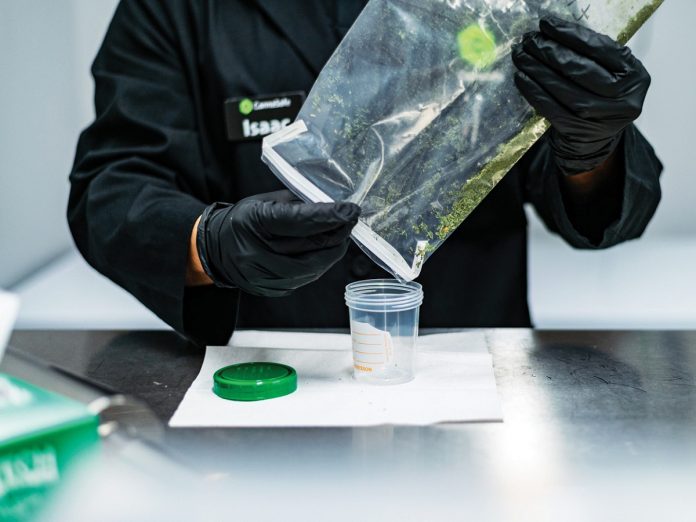Plants that yield beneficial compounds and raw materials—useful crops like corn or tobacco—go from being greenery to commodities to products for consumer markets. But unlike corn or tobacco, when a plant is singled out as illegal, it becomes rough trade. There are no rules in a rogue market except among purists, fanatics, and craftspeople with ethics. Illegal operators are interested in profits, not product safety. There’s nothing new about that.
What is new, in a quasi-legal market like cannabis, is third-party testing of raw plant material, extracts, and other products so consumers can feel comfortable about what’s in their stash.
Or can they?
Technological advances in laboratory equipment and the search for the unknown practically ensure new chemicals and compounds will be discovered daily, which yields endless opportunities for biochemists and researchers to develop new organic and synthetic compounds to be used in all kinds of goods.
Science and industry have exploited many botanicals as source materials for refined chemicals, pharmaceutical ingredients, industrial materials, food and beverage additives, and so much more…but not so much the shady cannabis plant.
Unregulated commodities cannot be held to a common standard, and while marijuana was illegal, cannabis cultivation and product production were shrouded in mystery. Without industry standards or legislated guidelines, it’s nearly impossible to establish a basis for research into any substance or how it should be used.
It’s nothing short of revolutionary for the modern cannabis consumer to be able to look at the certification label on a legal product and know where materials came from, who produced it and when, which batch it was part of, and when it was lab-tested. Test results also are readily available to consumers, revealing percentages of various cannabinoids and testifying to the product’s freedom from contaminants.
But does that really mean people know what’s in their weed?
Pick your poison
“Federal regulation is necessary to bring uniformity across the nation,” said Antonio Frazier, vice president of operations at testing laboratory CannaSafe. “California’s regulations are the toughest in the nation, but they ensure consumers are getting access to product [that is] the cleanest cannabis product around.
“The vape crisis has shown us the illicit market is more focused on profit than safety,” he added.
The vape crisis: Reports of a mysterious respiratory condition related to e-cigarettes and vaporizers began receiving widespread attention in the United States after Labor Day 2019 and, by the end of September, thirteen patients in ten states had died. There was no name for the new condition for a few weeks, but by late October the burgeoning epidemic had been labeled EVALI (E-cigarettes or Vaping product use Associated Lung Injury) by the Centers for Disease Control and Prevention (CDC).
The number of fatalities stood at fifty-four in mid-December. By then, more than 2,000 patients spanning all fifty states and two U.S. territories had been diagnosed.

Despite an ongoing investigation mounted by the CDC in cooperation with state public health officials, investigators from the Drug Enforcement Administration (DEA) and other federal agencies, and respiratory specialists at major hospitals, there is still no single product or substance that has been determined to be the culprit. In early December, the CDC fingered a primary suspect—vitamin E acetate, used in black market vapes as a thickener or “cut” to fill cartridges short on cannabis oil—but health officials at all levels cautioned other factors might be at work, as well.
“…[T]he findings do not rule out other possible compounds or ingredients that may be involved in causing these lung injuries,” said Minnesota Department of Health State Epidemiologist Dr. Ruth Lynfield, echoing her colleagues at other federal and state agencies.
Patients were spread out in legal and non-legal states; some vaped nicotine, some THC, and some both. Some had purchased products at legal vape shops or dispensaries, and some products were sourced from illicit vendors.
To add further complications, illicit products, their ingredients, and the concentrations used can vary from batch to batch. Some vape enthusiasts mix their own custom concoctions (e-fluids and THC-infused oils) to be smoked with a personal vape rig. More commonly, bootleg and counterfeit vape cartridges that are used with a pen-shaped battery can be churned out in the privacy of an illegal producer’s garage or basement.
It’s hard to tell exactly what is in these products, which ingredients may be potentially toxic in what combination, and whether any of the ingredients may produce a toxic reaction when super-heated into vapor form except in a laboratory environment.
When experts first postulated a link between the epidemic and vitamin E acetate early in the crisis, CannaSafe hunted down seven legal and seven illicit cartridges and subjected them to rigorous analysis. “We started looking more into illicit carts earlier this year when the illness started to gain more traction,” Frazier said. “Our main findings were the significant amounts of pesticides and vitamin E in the oil of illicit carts. Vitamin E was present at anywhere between 25 percent and 40 percent [total fluid volume], and some pesticide [levels that] were more than 1,000 times the legal limit in California.”
The test results from CannaSafe, which were reported by CBS and NBC News in segments on the vaping crisis, were disturbing. In the final report, Vapes: What are you Actually Inhaling? published by CannaSafe in November, the lab minced no words in its conclusions. “Just like with the oil, we were most shocked at what we found in the vapor of the illicit carts,” Frazier said, explaining cartridge contents were tested in oil form and also when heated into vapor. “We found formaldehyde, carbon monoxide, and hydrogen cyanide in the illicit carts.” Those are some of the same toxic byproducts of tobacco combustion.
What kind of symptoms might users notice if they vaped the dangerous toxins?
“The levels of carcinogens and other acute toxins could show immediate adverse effects like headaches and respiratory discomfort, but ultimately lead to cancer and other respiratory issues over long-term usage,” Frazier said.
Four areas of concern outlined in the report included cutting agents (particularly vitamin E acetate), vaping temperatures, flavorings, and exposure to heavy metals from vaping hardware. Highlights included:
- Out of seven illicit cartridges, five contained between 30 percent and 37 percent vitamin E acetate.
- Two of the seven illicit products were counterfeits of popular legitimate brands Kingpen and Stiiizy in similar packaging.
- When exposed to ultra-high temperatures, even legal cartridges could produce “unfavorable chemicals.”
- Without an industry-wide temperature measurement standard, consumers could not be expected to be aware of safe vaping temperature ranges.
- Flavorings created from organic or synthetic plant terpenes and commonly used in food and other consumables may create a toxic reaction when heated into vapor and inhaled—especially synthetic terpenes.
- Flavorings appeal to underage vape users.
- Actual percentages of THC and CBD in the illicit products varied widely, while none of the legal cartridges contained less than 82 percent cannabinoids.
- Heavy metals pose a significant threat in black market products. “Our study found the illicit CBD cart bought online contained over seventeen times the acceptable amount of lead (0.5 ug/g),” Frazier said. “The cart measured 8.640 ug/g of lead, which may be due to leaching introduced from the hardware.”
Despite CannaSafe’s distressing findings, Frazier remains pro-vape. “Vaping is a critical delivery method for sick patients who need rapid onset of their medicine,” he said, echoing the position of other advocates who have pointed out vaping has helped smokers quit conventional cigarettes. “Any licensed vape that has proper temperature controls and ratios of terpenes similar to what’s in the plant is safe for consumption.”
But there’s no denying EVALI has put a chill on the U.S. vaping market, for both nicotine and cannabis. Popular e-cigarette manufacturer Juul removed all flavors except tobacco and menthol from its cartridge selection. Regional bans on flavored products or blanket bans have been implemented in New York, Michigan, Massachusetts, Oregon, Rhode Island, and Montana.
“I think the stigma certainly hurts, but these events have further separated products between the legal and illicit markets,” Frazier said. “Now the industry is aware of where these dangerous products are coming from, but we need to educate the public and consumers.”
What about hemp?
Florida-based Kaycha Labs operates testing facilities in Davie and Gainesville, Florida; Knoxville, Tennessee; Oklahoma City; Warwick, New York; Mount Washington, Kentucky; Denver; and Los Angeles. Co-founder and President Chris Martinez said the lab tests cannabis and hemp “flowers and trim, [all forms of extracts and] concentrates, edibles and tinctures, and topicals and transdermals.”
Particularly in the southern states of Florida, Kentucky, and Tennessee, hemp is a hot issue for farmers eager to fill their fields with a profitable crop. Legislation allowing the development of industrial hemp farming was part of the Agriculture Improvement Act of 2018, more commonly known as the Farm Bill, championed by Kentucky Senator Mitch McConnell (R) and a bipartisan coalition.
Hemp is Cannabis sativa that contains no more than 0.3 percent by dry weight of the psychoactive cannabinoid THC—a trace amount that will not produce a “high.” Uses for hemp date back 10,000 years and include rope, textiles, and industrial oil lubricants. The plant’s seeds have been marketed as a “super food” and incorporated into birdseed and granola for decades. Now that farming the crop is legal, pressure has been mounting on the Food and Drug Administration (FDA) to issue clear policy governing hemp-based products—especially because hemp is the primary source for the popular cannabinoid CBD.
Due to hemp’s shared history with marijuana, the FDA likely will issue regulations similar to those already in place for cannabis in legal states—including third-party testing for purity and potency. Kaycha Labs already tests hemp and CBD products for producers that want to certify product quality as well demonstrate adherence to the federally mandated THC ceiling.
“CBD samples fail compliance testing more often than THC, and no specific region stands out among the data,” Martinez said. “Half the people making CBD products have no previous experience in formulation and create products with contaminated raw materials. Common reasons why products fail testing include potency, pesticides, heavy metals, residual solvents, terpenes, microbials, mycotoxins, and label claim verification.”
Martinez went on to explain some differences and similarities between testing THC-infused products and CBD-infused products. “Potential toxins and contaminants may exist in both products, and because both products are so similar [plant-wise], we have similar testing techniques for both hemp/CBD and cannabis/THC,” he said. “The exception is when we are testing for volatile pesticides. This is only required for cannabis/THC and not required for hemp/CBD.
“This is surprising to us, because the hemp plant sponges contaminants from the soil, called phytoremediation, and that’s how it’s able to clean up [a toxic] area,” he continued. “In fact, industrial hemp was grown around the abandoned Chernobyl nuclear power plant in Pripyat, Ukraine, to reduce soil toxicity. So, when it comes to hemp-derived products, consumers should pay more attention to the reputation and history of the company.”
Phytoremediation in Chernobyl? Yet another miraculous use for the wonder plant hemp, but also a concern for CBD retailers and users, especially if they’re not sure about a product’s origin, certified testing requirements, or quality standards.
A trend toward organic hemp already has begun among craft growers in cannabis-legal states like Oregon and Colorado. The only way to verify whether hemp is completely organic is with testing—or federally issued policies and guidelines, so the government, cannabis producers, ancillary businesses, vendors, and consumers can be on the same product-safety page.
Until that day comes, Martinez had more advice for wary cannabis customers.
“First and foremost, educate yourself as a consumer,” he said. “Do not buy black market products. Read the labels and buy from vendors who have their products fully tested with a certificate of analysis via reputable testing laboratories.”
Nothing new
In the story of modern cannabis (since U.S. federal prohibition was established in the 1930s), perhaps the most memorable, modern incidence of toxic contaminant use on cannabis came in the mid ’70s, when the U.S. government sprayed the herbicide paraquat on Mexican marijuana crops in an effort to eradicate the budding illegal industry.
Many an outlaw on both sides of the border smoked the paraquat-ed pot, cursed Nixon, and dared the DEA to spray, and spray some more. Studies found exposure to paraquat may be linked to Parkinson’s disease; developed by Chevron, it’s also known as methyl viologen. Paraquat now is outlawed in several countries.
It could be argued that an organic herbicide like paraquat is a mild toxin compared to contaminants that could lurk in today’s unregulated cannabis products. In 1975, high-potency cannabis strains, extracts, edibles, and vaping products were not widely available. Neither were there as many commonly used chemicals and additives as there are today. Illicit marijuana operators ignored prohibition then, and they still do.

TOXIC SHOCKING
It’s impossible to know exactly what is in any product that does not come from a legitimate, licensed manufacturer via a licensed retail vendor through a regulated supply chain that includes third-party testing. Unlicensed manufacturers are completely unregulated and unburdened by conscience.
Amidst the vaping crisis that emerged in September 2019, cannabis testing lab CannaSafe tested fourteen THC cartridges, half of which were illegally produced and/or counterfeits. The Centers for Disease Control and Prevention also tested vaping products obtained from EVALI patients. Both organizations found disturbing contaminants including…
Vitamin E acetate
Called out in November by the CDC as a substance of interest when it showed up in the lung fluid samples of twenty-nine EVALI patients, vitamin E acetate now is a prime suspect in investigations. The substance is commonly used as a thickening agent in topical applications and ingestible formulas but can damage lung tissue when inhaled.
CannaSafe’s report Vapes: What Are You Actually Inhaling? stated, “Colorado is the closest to implementing regulations with a ban on polyethylene glycol (PEG), vitamin E acetate, and medium chain triglycerides (MCT oil) as additives to vape cartridges that could go into effect as early as January 1, 2020.”
Formaldehyde, carbon monoxide, hydrogen cyanide
CannaSafe’s test results showed vapor from three of the illicit carts contained formaldehyde, carbon monoxide, and hydrogen cyanide. All are extremely toxic. Both carbon monoxide and hydrogen cyanide have been found to cause “asphyxia, cardiac arrest, and death” when firefighters are exposed to the chemicals during intense wildfires. Entire families have died in their sleep after faulty home heating systems emitted colorless, odorless carbon monoxide. Formaldehyde, a drying agent used in embalming fluid, antiseptics, and paint, is a lung irritant that has been linked to cancer, asthma, and allergies.
Heavy metals
Heavy metals—high-density, naturally occurring elements including arsenic, cadmium, chromium, lead, thallium, and mercury—can be toxic in small amounts. The CannaSafe report pointed out further research is needed to determine how vaping equipment, including cartridges and batteries, may expose users to trace amounts of the substances, since vaping hardware remains mostly unregulated. Illicit cart vendors often source vape equipment that is mass-produced in China or imported from other global markets where manufacturing likely is unregulated.
Mold
Any organic material, when processed and stored incorrectly, will mold. Plants grown in damp environments with poor air circulation are particularly vulnerable. Once mold sets in, there’s not much to do with the product except dump it as spoilage. Mold is a respiratory irritant that should not be inhaled, especially by those with asthma, chronic lung infections, COPD, or a compromised immune system.
Pesticides
Chemical pesticides are no better for humans than for pests. During raids in 2018, California authorities found dangerous pesticides at nine out of ten illegal grows. In one case, authorities confiscated carbofuran, a banned neurotoxic rodenticide so potent a quarter teaspoon can kill a 300-pound bear. CannaSafe found “significant amounts” of pesticides in some of the illicit THC cartridges it tested, including “some pesticide [levels that] were more than 1,000 times the legal limit in California.”











